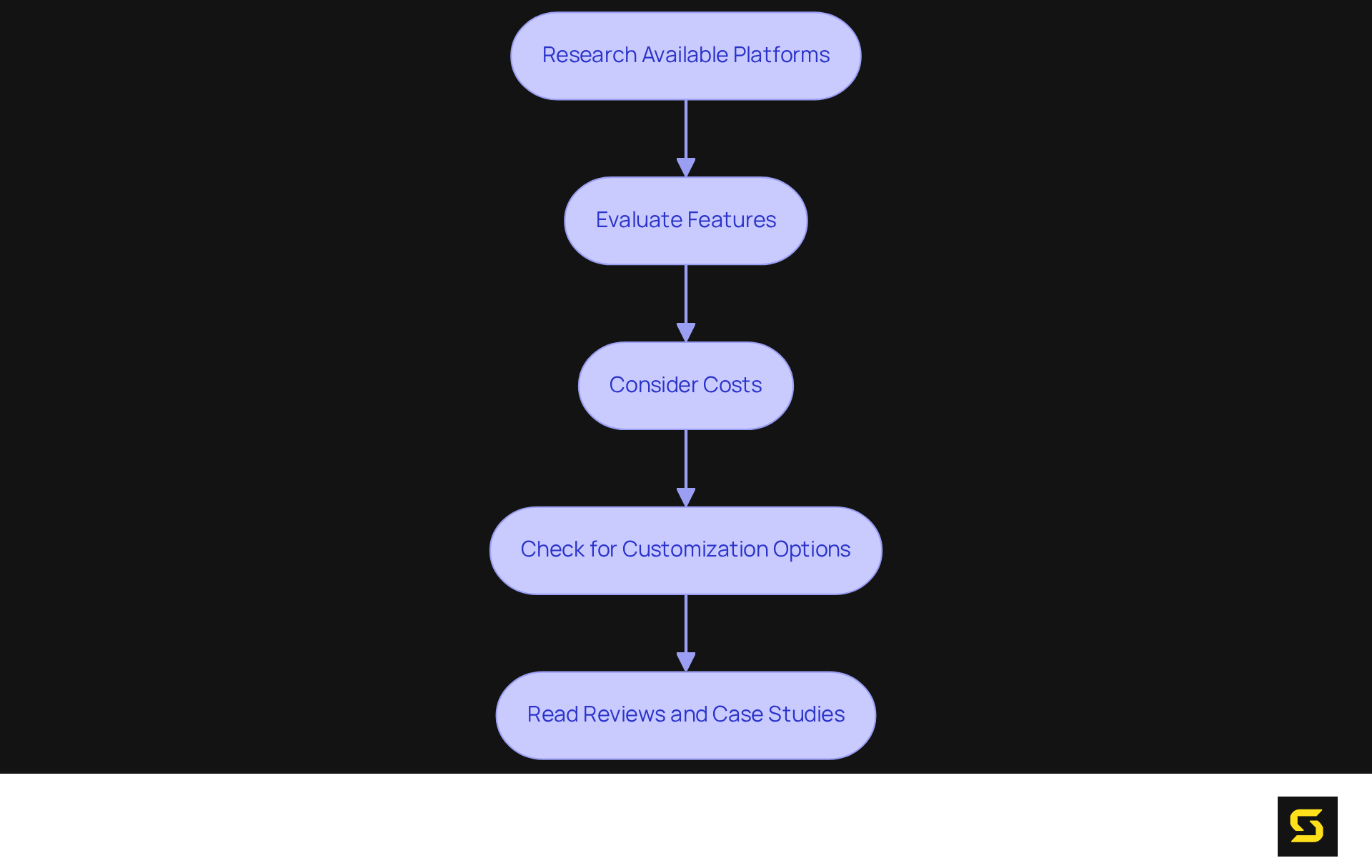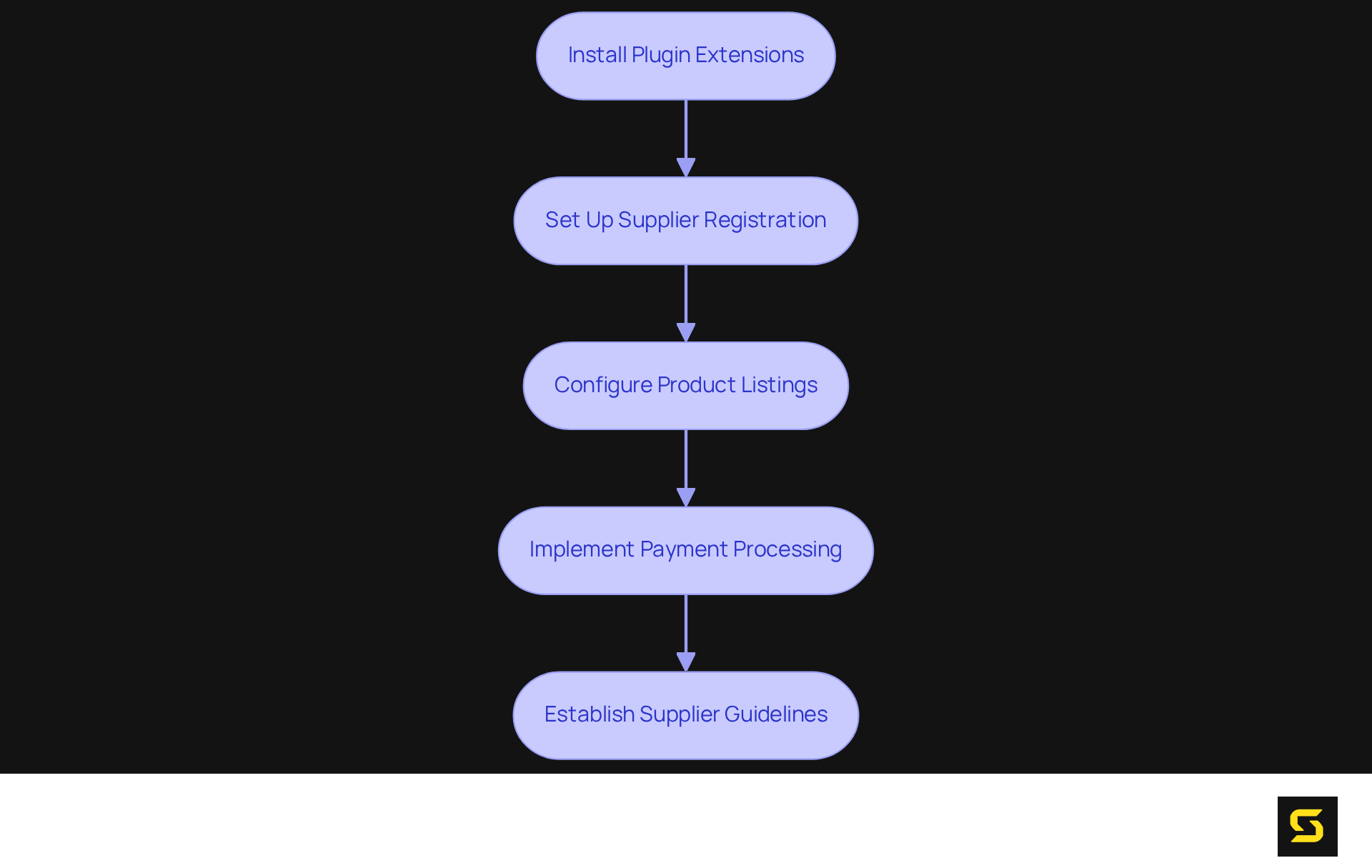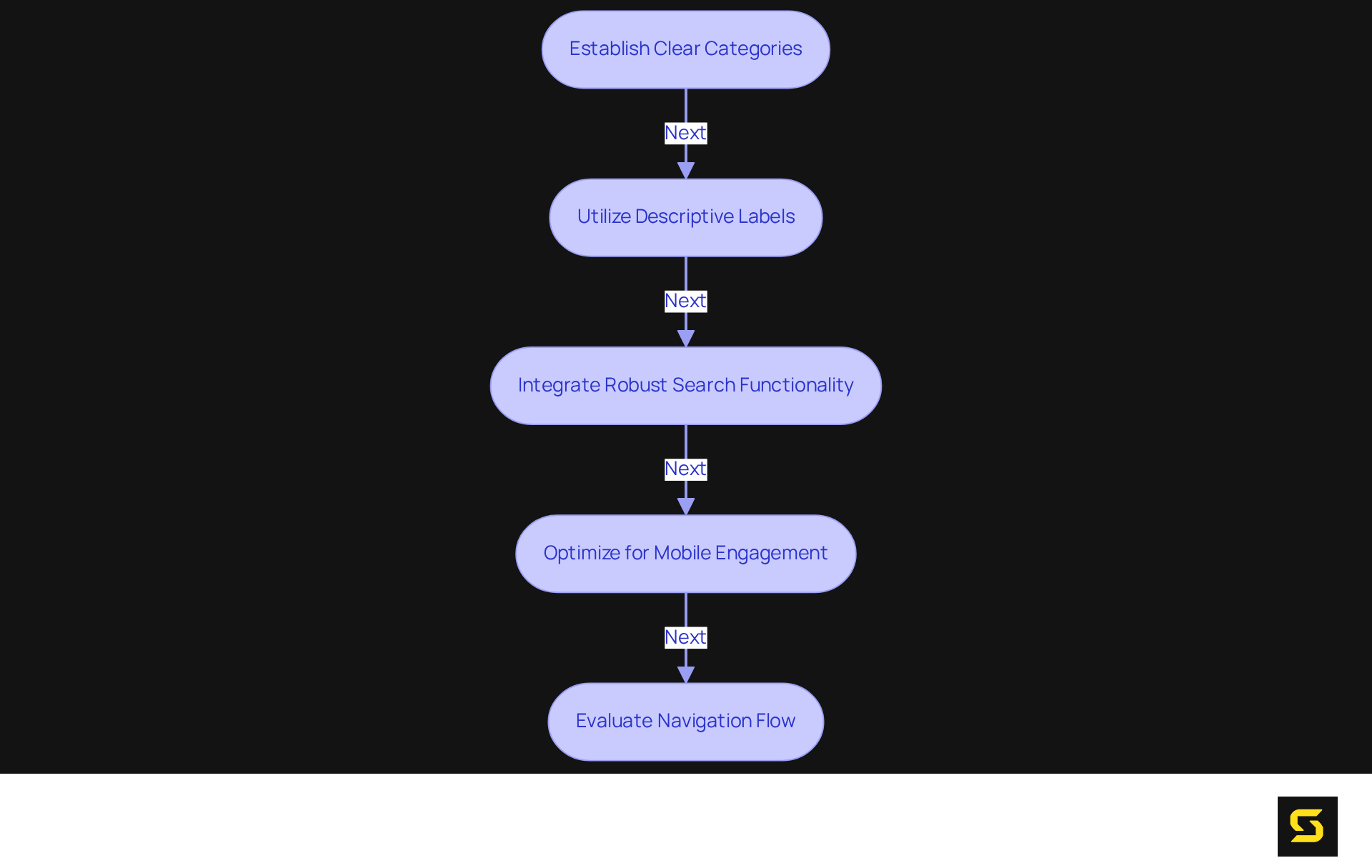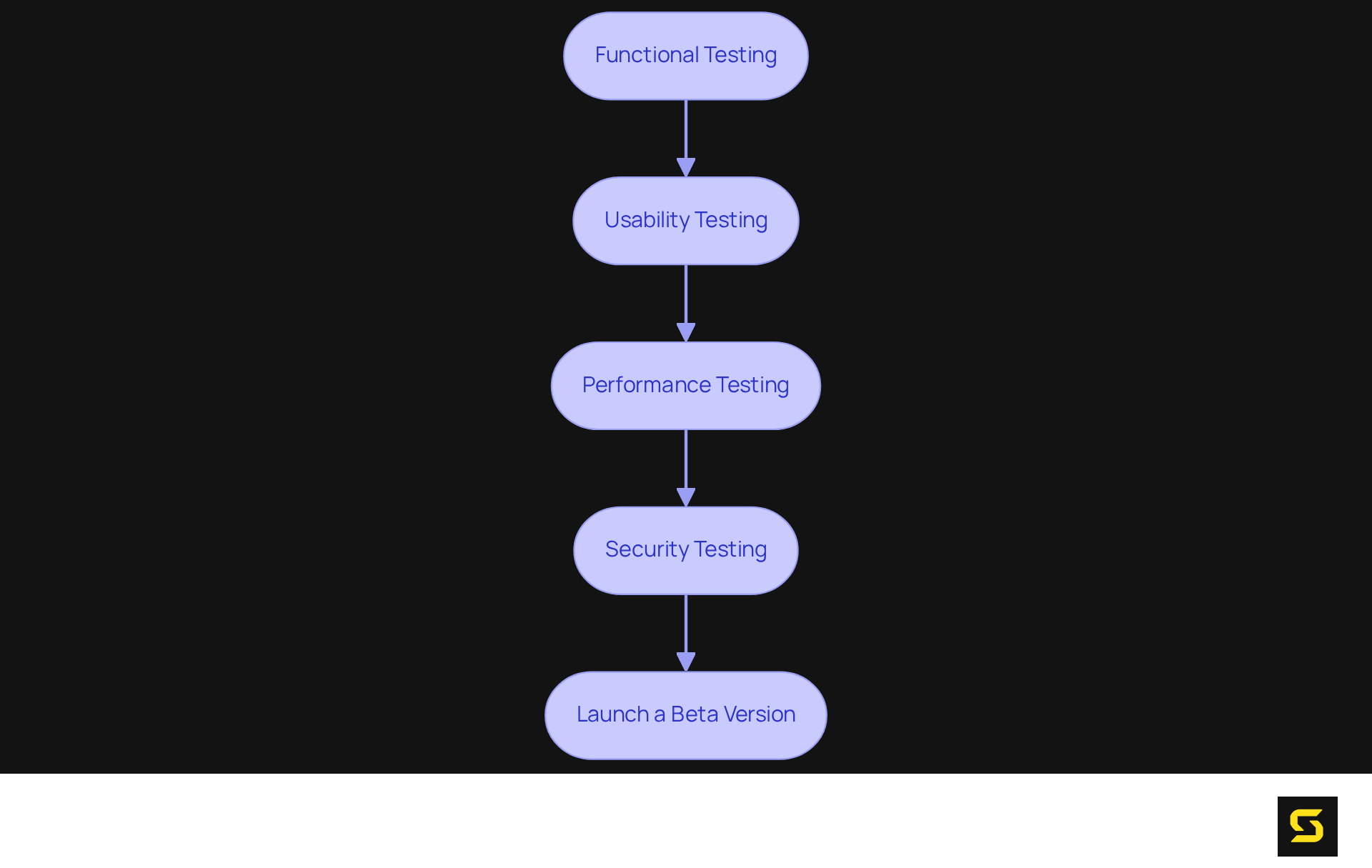Overview
To build your online marketplace successfully, it is essential to adopt a structured approach. This includes:
- Selecting the right eCommerce platform
- Transforming your site
- Implementing account management features
- Designing intuitive navigation
- Conducting comprehensive testing
Each of these steps is crucial for ensuring a seamless and effective marketplace launch. Research, user experience, and security measures play significant roles in this process. By prioritizing these elements, you can create a marketplace that not only meets but exceeds user expectations. Take action now to implement these strategies and secure your marketplace's success.
Introduction
Building an online marketplace represents a transformative venture. However, navigating the complexities of eCommerce platforms and supplier management can be daunting. This guide provides a structured approach, outlining essential steps to create a successful online marketplace that not only attracts vendors but also enhances the shopping experience for customers.
With myriad options available and the rapid evolution of digital commerce, entrepreneurs must ensure they choose the right strategies to stand out in an increasingly competitive landscape.
Establish Your eCommerce Platform
- Research Available Platforms: Begin your journey by thoroughly researching prominent eCommerce platforms such as Shopify, WooCommerce, and Magento. Consider critical factors like ease of use, scalability, and the array of available features. Notably, as of 2025, Shopify commands a substantial market share, underscoring its popularity among startups and small businesses. In fact, in 2021, more individuals searched for 'How to start a business' than 'How to get a job,' reflecting a burgeoning interest in eCommerce solutions.
- Evaluate Features: Identify essential features such as multi-vendor support, payment gateways, and inventory management. Ensure that the marketplace online you select can meet the specific requirements of your business. For instance, Magento is renowned for its adaptability and scalability, making it suitable for complex commercial needs.
- Consider Costs: Conduct a thorough analysis of the pricing structure for each platform, taking into account transaction fees, subscription costs, and any additional expenses related to plugins or themes. Understanding the is vital; platforms like Shopify may present higher upfront costs but offer extensive support and resources that can justify the investment.
- Check for customization options: Verify that the platform allows for customization to tailor the marketplace online to your brand and audience needs. Magento, in particular, is celebrated for its robust customization capabilities, empowering companies to create personalized interactions.
- Read Reviews and Case Studies: Seek out user reviews and case studies to gain insights into the experiences of other businesses utilizing the platform. For example, the partnership between Sproutwell and Firefly resulted in a remarkable 14.5X return on ad spend and a 27% month-on-month revenue increase, illustrating the potential advantages of effective platform implementation. Additionally, consider insights from industry leaders like Bill Gates, who asserts that your most dissatisfied customers are your greatest source of learning, emphasizing the critical role of customer feedback in the evaluation process.

Transform Your Site into an Online Marketplace
- Install Plugin Extensions: To enhance platforms like WordPress, begin by installing plugin extensions such as Dokan or WC Vendors. These tools facilitate multi-vendor capabilities, allowing for seamless integration of various sellers into your platform.
- Set Up Supplier Registration: Establish a streamlined registration process that enables suppliers to easily sign up and manage their own stores. This process should encompass necessary documentation, including tax identification numbers and bank details, to ensure compliance and security. In 2025, all major marketplaces will require sellers to register as either individual entrepreneurs or legal entities, making this step vital for legal compliance.
- Configure Product Listings: Empower sellers to add, edit, and manage their product listings effectively. This includes allowing them to upload high-quality images, set competitive prices, and manage inventory levels, which are essential for maintaining product availability and ensuring customer satisfaction.
- Implement Payment Processing: Integrate reliable payment gateways that facilitate secure transactions between buyers and various sellers. This integration ensures a , which is crucial for building trust and encouraging repeat business.
- Establish Supplier Guidelines: Develop comprehensive guidelines for suppliers that clarify expectations regarding product quality, customer service, and adherence to market policies. Emphasizing the importance of establishing trust through ratings and reviews can enhance transparency and foster a reliable atmosphere for both suppliers and customers.
In 2025, the number of suppliers utilizing multi-supplier platforms is projected to increase significantly, with sales through multivendor trading platforms estimated to reach $8.7 trillion. Successful examples of supplier registration processes can be observed in established marketplaces, where user-friendly interfaces and efficient onboarding practices lead to greater supplier satisfaction and retention. Best practices for supplier registration include simplifying the application process, providing clear instructions, and ensuring prompt communication to elevate the overall experience for new suppliers.

Implement Account Management Features
- Account Registration and Profiles: Establish a robust account registration system in the marketplace online that empowers both buyers and vendors to create comprehensive profiles. This functionality enables users to manage their information efficiently and monitor their activities seamlessly.
- Order Management: Deploy a sophisticated order management system that allows users to access their order history, track shipments in real-time, and handle returns or exchanges directly from their accounts. By 2025, effective order management systems will be indispensable for boosting customer satisfaction and operational efficiency. A recent study indicates that businesses optimizing their order management processes can achieve a 20% increase in customer retention rates.
- Communication Tools: Integrate advanced messaging features that facilitate direct communication between buyers and sellers. This capability is essential for addressing inquiries and providing support, ultimately enhancing the customer experience.
- Review and Rating System: Develop a transparent review and rating system in the marketplace online that enables users to provide feedback on products and suppliers. This feature not only but also motivates vendors to uphold high standards of service and product quality. As Bryden McDonald observes, "The best account managers act as trusted advisors, seamlessly integrating creative and media strategies while navigating complex stakeholder dynamics to deliver results."
- Security Features: Emphasize the implementation of stringent security measures, including two-factor authentication and secure password management. These features are critical for protecting accounts and ensuring a secure shopping environment in the marketplace online, which is increasingly vital as online transactions proliferate. A case study from a leading eCommerce platform revealed that robust security measures reduced fraudulent transactions by 30%, significantly enhancing client trust.

Design Intuitive Navigation Menus
- Establishing clear categories is essential for organizing products into distinct, logical categories that accurately reflect the marketplace online's offerings. This structure not only simplifies browsing but also enhances customer satisfaction by enabling clients to swiftly locate what they need. Efficient product classification can significantly boost sales, as individuals exploring New Arrivals are more inclined to purchase full-priced items.
- Utilize Descriptive Labels: Menu labels must be clear and descriptive, steering clear of jargon that could confuse users. Employing straightforward phrases such as 'Men's Clothing' or 'Home Appliances' facilitates effortless navigation, aligning with user expectations and enhancing overall usability. As Scott Belsky emphasizes, simplicity in UX design is paramount for effective navigation.
- Integrate Robust Search Functionality: A powerful search bar is indispensable for allowing users to quickly locate specific products or vendors. This feature addresses customer preferences, as many shoppers prioritize rapid access to desired items, significantly enhancing their shopping journey.
- Optimize for Mobile Engagement: With an increasing number of individuals shopping via smartphones, it is imperative to design navigation menus that are on mobile devices. Ensuring that menus are easily accessible and functional on smaller screens can lead to heightened engagement and conversion rates. Testing navigation across various devices is crucial to guarantee a seamless interaction.
- Evaluate Navigation Flow: Conducting usability testing is vital for gathering feedback on the navigation process. Observing how users interact with the menu allows for necessary adjustments based on authentic feedback, ensuring that navigation remains intuitive and effective. Regularly examining analytics can also reveal areas needing improvement, further refining the user experience. Remember, 61% of consumers will choose to shop with a competitor after just one negative encounter, underscoring the importance of intuitive navigation.

Conduct Comprehensive Testing of Your Marketplace
- Functional Testing: It is crucial to verify that all features—account registration, product listings, and payment processing—function as intended. This step ensures a and builds confidence in your platform's capabilities.
- Usability Testing: Engage actual participants in testing to gather valuable feedback on the overall experience. This process not only identifies areas for enhancement but also demonstrates a commitment to user satisfaction.
- Performance Testing: Rigorously evaluate the platform's performance under various conditions, including high traffic scenarios. This assessment is vital to ensure that your marketplace can accommodate demand without compromising user experience.
- Security Testing: Implement comprehensive security testing to uncover vulnerabilities and safeguard user data. Protecting sensitive information is paramount in establishing trust and credibility with your audience.
- Launch a Beta Version: Strategically consider launching a beta version of the marketplace to a limited audience. This approach allows for gathering critical feedback and making necessary adjustments before the full-scale launch, ensuring a polished final product.

Conclusion
Building a successful online marketplace demands a strategic approach encompassing various critical steps. Selecting the right eCommerce platform and implementing effective account management features are essential, as each element plays a vital role in crafting a seamless user experience. By adhering to these outlined steps, businesses can transform their eCommerce sites into thriving marketplaces that cater to both buyers and sellers.
Key points discussed include:
- The significance of researching and evaluating eCommerce platforms to identify the best fit for your business needs
- Ensuring robust supplier registration and management processes
- Designing intuitive navigation that enhances user engagement
Furthermore, comprehensive testing is indispensable for identifying potential issues and refining the platform prior to launch, ultimately leading to a more reliable and enjoyable shopping experience.
In conclusion, the journey toward establishing a successful online marketplace necessitates meticulous planning and execution. By emphasizing user experience, security, and effective management, businesses will not only attract suppliers and customers but also cultivate long-term loyalty. As the eCommerce landscape continues to evolve, it is imperative to stay informed about best practices and adapt to emerging trends, ensuring any marketplace aims for success in the competitive digital arena.
Frequently Asked Questions
What should I consider when choosing an eCommerce platform?
When choosing an eCommerce platform, consider factors such as ease of use, scalability, available features, and costs. Popular platforms include Shopify, WooCommerce, and Magento, each offering different strengths.
What are essential features to look for in an eCommerce platform?
Essential features include multi-vendor support, payment gateways, and inventory management. It's important to select a platform that meets the specific needs of your business.
How do costs vary among eCommerce platforms?
Costs vary based on transaction fees, subscription costs, and additional expenses for plugins or themes. Understanding the total cost of ownership is crucial, as platforms like Shopify may have higher upfront costs but offer extensive support.
Why is customization important in an eCommerce platform?
Customization is important because it allows you to tailor the online marketplace to fit your brand and audience needs. Magento is particularly known for its robust customization capabilities.
How can I gain insights into different eCommerce platforms?
You can gain insights by reading user reviews and case studies. These resources provide information about other businesses' experiences with the platform, helping you make informed decisions.
What steps are involved in transforming a site into an online marketplace?
Steps include installing plugin extensions for multi-vendor capabilities, setting up a streamlined supplier registration process, configuring product listings, implementing payment processing, and establishing supplier guidelines.
What is the significance of supplier registration in an online marketplace?
Supplier registration is vital for legal compliance, as all major marketplaces will require sellers to register as individual entrepreneurs or legal entities by 2025. It ensures that suppliers can manage their stores effectively.
How can I ensure a smooth payment experience for customers?
To ensure a smooth payment experience, integrate reliable payment gateways that facilitate secure transactions between buyers and sellers. This builds trust and encourages repeat business.
What guidelines should I establish for suppliers?
Establish comprehensive guidelines that clarify expectations regarding product quality, customer service, and adherence to market policies. Emphasizing trust through ratings and reviews is also important for transparency.
What is the projected growth of multi-supplier platforms by 2025?
By 2025, the number of suppliers using multi-supplier platforms is expected to increase significantly, with sales through these platforms projected to reach $8.7 trillion.





